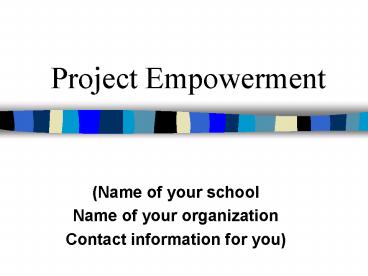Project Empowerment PowerPoint PPT Presentation
1 / 16
Title: Project Empowerment
1
Project Empowerment
- (Name of your school
- Name of your organization
- Contact information for you)
2
Drunk Sober
3
- Everybody thinks everybody else does more of
everything than they actually do. - We tend to overestimate how much other people do
unhealthy things and underestimate how often
people do healthy things.
4
Norms and Misperceptions
- Norm an unspoken social rule or code about how
people are supposed to behave or what they are
supposed to believe. - Norms influence our behavior.
- People have to infer what norms are. Norms are
not explicitly taught or explained. - As a result, people misperceive what the norms
are. - Misperceived norms are as powerful as actual
norms in influencing behavior.
5
Media Literacy
- What does NEWS mean?
- We notice the difference not the pattern.
- Out of the Ordinary gets the attention.
- Focusing on the unusual makes it appear usual.
- Not-Normal behavior looks like the Norm.
6
Misperceived Norms
- A misperceived norm will be perpetuated if most
people believe most other people think it is
true. - Ex (Your school) is a party school.
- Even if you dont personally agree with the
misperceived norm, if you think everyone else
does thats enough to perpetuate the
misperception (for you and for others). - When most people think unhealthy behavior is the
norm, that allows the unhealthy behavior to go
unchallenged.
7
Comparing Perceptions to Reality
- The alcohol survey you completed provided us with
what you estimated norms are for alcohol related
behaviors among various students (your group, and
students campuswide). - This presentation will compare your groups
estimates (i.e. perceptions) with the actual
behavior of these other groups.
8
Collecting Data on Actual Behaviors of your group
and (your school)
- You reported how much you engage in certain
behaviors and so did other students. - This provided the data for the actual norms for
your group. - A campus wide mailed random sample survey
provided information about actual norms for the
campus.
9
10
11
On average how many drinks do the following
groups have when they consume alcohol?
You
Actual
estimated
findings
Your Group
Students at
(Your school)
12
How often do the following groups drink per week?
You
Actual
estimated
findings
Your Group
Students at
(Your school)
13
Of students who do drink, what percentage of
students practice the following behaviors when
they drink?(percentage of respondents answering
always or usually.)
_ of students in
_ of students
your group do
campuswide do
this
this
Eat before and
during drinking
Have a
designated driver
Choose
beverages you
know the alcohol
content of
Limit spent
on alcohol
14
During the past 30 days, what percentage of
students engaged in the following behaviors?
_ of students in
_ of students
your group
campuswide
did this
did this
Intervened with a
drunk friend to
prevent injury
Prevent friend from
going home with
someone they
might regret
Intervened to keep
someone from
being a victim or
victimizing
someone
15
During the past 30 days, what percentage of
students engaged in the following behaviors?
_ of students in
_ of students
your group
campuswide
did this
did this
Went to a
party/social
activity not
serving alcohol
Did something
fun without
alcohol
Refused an offer
of alcohol
16
WHAT HAVE WE LEARNED?
1. Were more likely to drink more heavily if
we think other students drink a lot, and that
they approve of heavy drinking. 2. Students
dont drink as much as you thought. 3. Most
students who do drink are more responsible than
we give them credit for. 4. Students are making
healthier choices than we realize, whether or
not they choose to drink.

